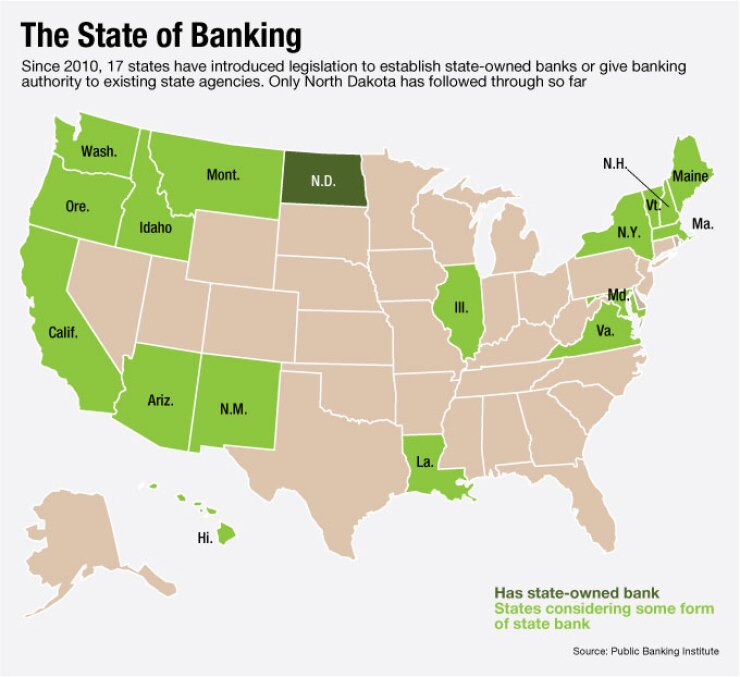-
California Assemblyman Ben Hueso, a Democrat, has introduced a bill to create a task force to consider the viability of forming a bank that'd use deposits of state agencies to support economic development.
May 16 -
A Virginia lawmaker is urging his colleagues in Richmond to consider creating a state-owned bank that would use deposits from residents and state agencies to lend to local businesses and stimulate economic growth.
December 28 -
Lawmakers in state capitals across the country are increasingly intrigued by arguments for public banks. With the financial crisis fueling disdain for the banking industry in general, some view these banks as an appealing alternative to a system they consider to be broken. But Eric Hardmeyer, president and chief executive of the Bank of North Dakota, is not so sure.
April 1 -
Data released Wednesday by the U.S. Small Business Administration shows that banks are willing to finance small businesses — as long as the loans are backed by a government guarantee.
October 5

A growing number of state lawmakers believe that a good way to lift the economy out of the doldrums is to get states directly involved in banking.
At least 17 states are considering bills to create a state-owned bank or give banking powers to existing state-government agencies. Backers say there would be at least two immediate benefits: a state-owned bank would partner with community banks to encourage lending, and the state would save millions of dollars on interest by holding its own deposits.
"Instead of sending the money off to Wall Street, keep it in house," says Ellen Brown, chairman and president of the volunteer, nonprofit Public Banking Institute, which is promoting the state-owned banks. When a state deposits funds in a privately owned bank, "it can wind up in Swiss banks, or it can be used for leveraged buyouts, or actually compete against the state's own businesses."
In the past two years, proponents of state banks have filed bills in states such as
The California Bankers Association opposed last year's legislation, saying that the cash-strapped state could not afford the losses that would accompany the formation of a bank, said spokeswoman Beth Mills. A state-owned bank would also compete with other banks for a limited supply of borrowers. The California Bankers Association has not yet taken a position on the bill introduced this year.
The assertion by state bank supporters that the banking industry doesn't want to lend is "ludicrous," says Frank Sorrentino, the chief executive of North Jersey Community Bank in Englewood Cliffs, N.J. "With the Federal Reserve keeping risk-free government securities at all-time-low interest rates and the federal funds rates at 0%, banks have nowhere to put their money," he says. "They have to lend to make money."
Recent data suggests that banks are lending again. Total loans at Dec. 31 grew 1.8% from Sept. 30, to $7.46 trillion, the Federal Deposit Insurance Corp. said last month. Commercial and industrial loans grew 4.9% in the fourth quarter, accounting for about half of the total loan increase.
The FDIC said in a report issued last week that the quarterly increase was the "largest real growth" in loans in four years.
Banks might be making more loans to larger companies, but they're making it more difficult for small businesses to obtain a loan, Brown says. "People used to be able to get a credit line from their bank at 8%, but now they have to get a credit card at 16%," says Brown, a former lawyer in Newhall, Calif., who wrote a book, "Web of Debt," about the Fed.
Even if banks say they've increased small-business lending, evidence suggests it's far less than what they are capable of providing, Brown says. "Whatever the too-big-to-fail banks are doing, they could be doing much more if they had the help of a public bank," she says.
All North Dakota agencies must deposit their funds in the Bank of North Dakota. Those funds are used for economic development, to provide capital to community banks, and to fund student loans.
Government-backed loans are not new. Privately owned banks often obtain federal guarantees through the U.S. Small Business Administration.
SBA loans have a government guarantee but they also represent a fraction of small-business loans.
Many banking observers are not convinced that state-owned banks are a good idea. Some question whether the Bank of North Dakota has played a significant role in the state's economy. North Dakota's economy has been no more stable than the economy of South Dakota, which also relies on agricultural commodity prices. South Dakota does not have a state-owned bank.
The cost of forming a state-owned bank could be substantial. If a large state such a Massachusetts formed a bank, it would require funds equal to 20% of the state's general obligation debt, according to the Federal Reserve Bank of Boston.
Giving states the power to guarantee loans could complicate existing regulation, says Kevin Jacques, a finance professor at Baldwin-Wallace College.
"You've got state-chartered banks, and federally chartered banks, and also state and federal regulators," says Jacques, a former Treasury Department economist. "That combination of state banks with state and federal regulators causes a lot of preemption-related issues. This would make it even worse."





